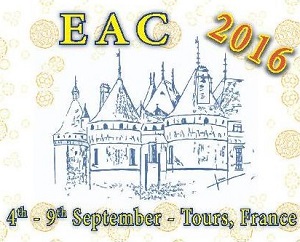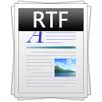
EAC 2016 - TOURS (FRANCE) SEPTEMBER 4-9, 2016
ABSTRACT SUBMISSION
LATE POSTERS DEADLINE EXPIRED ON JUNE 30TH.
Authors who are willing to submit a “late poster” have the possibility to submit an abstract through the EAC on-line submission system which is open again for the submission before the 30th of June for a "late poster" with abstract included in the program as well as in the USB key proceedings.
Notification of acceptance or rejection will be issued on 15 July 2016
Templates for the construction of abstracts are available below in doc, odt and tex format. Please convert your abstract in a PDF file for submission.
EAC2016 will be organized according to five main themes, which aim to increase understanding of the main scientific stakes in the conference. Each of these five themes will include several subtopics. Each subtopic refers to one major EAA WORKING GROUP (WG) or, if necessary, to several other WGs (see the list of WGs and abbreviations hereafter).
In addition, special sessions on particular topics will be held in response to requests from attendees.
Submitters should ascribe each abstract to the correct category in order to build coherently themed sessions. For that purpose, abstract subtopics and special sessions listed hereafter should be employed. Submitters can refer to previous EAC conference proceedings to determine where their abstract might best fit.
Abstract review
The abstracts for “late posters” will be reviewed by the two co-chairs of the EAC2016 Scientific Committee. Abstracts that do not fulfil the standards will be rejected. Please avoid submitting abstracts containing only future results. Accepted abstracts will be placed on the conference website and provided to conference attendees. Abstract titles and authors will be listed in the conference handbook.
EAA WORKING GROUPS (used abbreviations)
• AEROSOL-BASED NANOTECHNOLOGY (ABN)
• ELECTRICAL EFFECTS (EE)
• COMBUSTION AEROSOLS (CA)
• ATMOSPHERIC AEROSOLS (AA)
• INSTRUMENTATION (INST)
• PMx (PMx)
• INHALATION, EXPOSURES AND HEALTH (IEH)
• INDOOR AND WORKING PLACE AEROSOLS (IND)
• AEROSOL CHEMISTRY (AC)
• AEROSOL MODELLING (AM)
• FUNDAMENTALS (FUND)
HOW TO SUBMIT YOUR ABSTRACT?
- First of all, in the abstract classifications listed hereafter, you have to choose the theme fitting the best to the field of your work or application of your work;
- In a second step, inside the theme chosen, you have to select one subtopic that is more in keeping with the subject of your abstract. For your information, every subtopic refers to a major WG (placed in first position) and if necessary to several other WGs (used abbreviations in brackets).
MAIN Scientific themes, subTOPICS (EAA working groups) for abstracts submission:
1 - AEROSOL TECHNOLOGY
- Synthesis and structuring of functional nanoparticles by flame-based processes (ABN)
- Synthesis and structuring of functional nanoparticles by electrical discharges / plasmas (ABN, EE)
- Coating and surface modification of nanoparticles (ABN)
- Modelling of formation, dynamics and deposition of engineered nanomaterials (ABN, FUND)
- Process monitoring in synthesis and structuring (ABN, INST)
- Characterization and novel measurement techniques of aerosol-based nanomaterials (ABN, FUND, INST)
- Chargers and charging (ABN, EE)
- Filtration for functional materials, combustion and industrial aerosols (ABN, CA, FUND)
- Bio-electrostatic engineering (EE)
- Charged aerosol generation and applications (EE)
- Electrohydrodynamics effects and applications (EE)
- Electrostatic discharges, plasmas and related phenomena (EE)
- Electrostatic hazards and safety (EE, IEH)
- Fundamentals of electrostatics (EE, FUND)
- Measuring techniques of charged aerosols (EE, INST).
- Combustion of biomass and bio (renewable) fuels (CA)
- Combustion engine aerosols (CA, AA)
- High temperature aerosols (CA)
- Industrial aerosols (CA)
- Measurement techniques of combustion aerosols (CA, INST)
- Others topics related to Aerosol-based nanotechnology (ABN)
- Others topics related to combustion aerosols (CA)
- Others topics related to electrical effects (EE)
2 - ATMOSPHERIC AEROSOL STUDIES
- Aerosol Cloud interactions (AA, AC, AM)
- Climate effects of aerosols and global modelling (AA, AM)
- New particle formation (AA, AC, AM)
- Optical properties of atmospheric aerosols (AM, AA, AC)
- Physical and chemical properties of atmospheric aerosols (AA, AC, PMx)
- Remote sensing of aerosol properties (AA)
- Transport and transformation of atmospheric aerosols: Measurements and modelling (AA, AC, AM)
- Bioaerosols (chemical composition and physical properties) (AA, AC)
- Biomass burning (AA, AC, PMx)
- Carbonaceous aerosol in the atmosphere (AA, AC, PMx)
- Secondary Organic Aerosol (SOA) (AA, AC, AM)
- Marine aerosols (AA, AC, PMx)
- Mineral dust (AA, AC, AM, PMx)
- Urban aerosols (AA, AC, PMx)
- Sampling and sampling artefacts (PMx, AA)
- Source apportionment and data interpretation (PMx, AC, AM)
- Other
3 – AEROSOL MEASUREMENT TECHNIQUES
- Aerosol standards (INST)
- Novel measurement principles and new instrumentation (INST, FUND)
- Miniaturized instrumentation (INST)
- Instrument calibration (INST)
- Instrument accuracy and comparability (INST)
- Optical measurement techniques (INST)
- Electrical measurement techniques, including electrical mobility analysis (INST, EE)
- Mechanical/gravimetric measurement techniques, including impactors (INST, FUND)
- Chemical measurement instrumentation (AC, INST)
- Comparison of different measurement methods (INST, AA, ABN, PMx)
- Implementation of existing measurement methods and instruments for novel studies (INST, AA, ABN)
- Interpretation of data (PMX)
- Legislation and policy (PMX)
- Physico-chemical analysis (PMX)
- Sampling (PMX)
- Source apportionment (PMX)
- Instrumentation for chemical characterization of aerosol (AC)
- Other
4-AEROSOL AND HEALTH
- Aerosol-based medical diagnostics and drug delivery (IEH)
- Bioaerosols and allergens (IEH)
- Biological response of organisms, cells and proteins to particle exposure (IEH)
- Dosimetry and detection of particles in organisms, tissues and cells (IEH)
- Lung morphology and (patho-)physiology (IEH)
- Particle-induced health effects (toxicology, epidemiology) (IEH)
- Particle lung deposition, clearance and translocation to other organs (IEH)
- Aerosol and health (IEH, PMx)
- Health effects and environmental impact of engineered nanoparticles (IEH)
- Inhalation and exposures (IEH)
- Aerosol deposition (IND)
- Indoor aerosol transport (IND)
- Indoor/outdoor relationship (IND, PMx)
- Indoor sources (IND)
- Worker protection in nanoparticle industries (IND)
- Penetration (IND)
- Other
5-BASIC AEROSOL PROCESSES
- Molecular characterisation and identification of aerosol constituents and markers (AC)
- Multiphase chemical mechanisms, processes, and interactions involving aerosol (AC)
- Chamber and flow tube simulations – heat and mass transfer (AC, AM, FUND)
- Aerosol dynamics (FUND, AM)
- Aerosol interaction with surfaces (FUND)
- Aerosol filtration (FUND)
- Coagulation, Agglomeration, and Fragmentation (FUND, AM)
- Physical properties of aerosols (FUND)
- Nucleation and growth (FUND, AM)
- Optical properties (FUND, AA)
- Other






